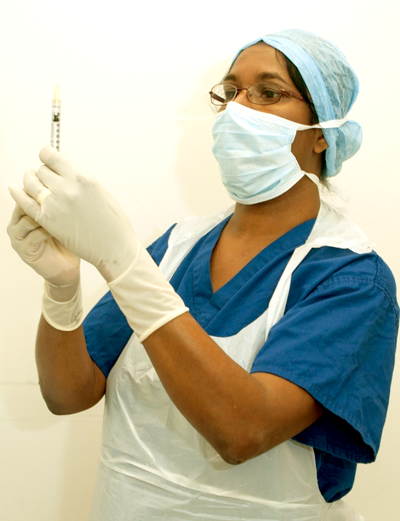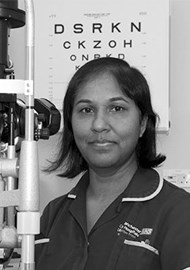Intravitreal injections of the anti-vascular endothelial growth factor (anti-VEGF) agent ranibizumab, for the treatment of wet age-related macular degeneration (AMD) was approved by National Institute for Health & Care Excellence (NICE) in 2008 [1]. The Manchester Royal Eye Hospital (MREH), a division of Central Manchester University Hospital Foundation Trust, established a ‘Macular Treatment Centre’ to treat patients initially using photodynamic therapy in 2004 and intravitreal injection therapy since 2007.
The demand for these treatments has constantly grown since then and has seen a further increase in demand after more retinal conditions and newer intravitreal drugs were approved for treatment in recent years. Early access to the injection is critical to prevent vision loss. The patients who are treated also require frequent and long-term follow-up for treatment to be most effective [2]. As the population continues to age more patients will be diagnosed and require treatment, resulting in a dramatic increase in need for anti-VEGF therapy; health services are set to face a great capacity challenge to treat all patients.
MREH recognised that the volume of injection treatments, required on such a frequent basis, was becoming too great to be delivered by doctors alone. The Royal College of Ophthalmologists (RCOphth) has acknowledged the challenges related to medical staffing levels [3]. An early document discussed that training of clinical nurse specialist / technicians to perform intravitreal injections may offer a potential solution to reduce pressure on the medical retinal services. At the time though the greater pressure was thought to be on assessment of patients rather than injection and acknowledgement was given to nurses and optometrists who were providing a pivotal role in this aspect of patient care management.
In their more recent recommendation the RCOphth [4], responding to a practice that had already started in some eye units allowing non-medical practitioners to perform intravitreal injections, set out key principles that should underpin and guide the training for and delivery of such services by non-medical practitioners. At MREH the service was developed by introducing clinical nurse specialist (CNSs) injectors.
Ophthalmology in the UK has embraced modernisation of nursing roles and quality improvement, particularly within cataract care [5]. The Modernisation Agenda part of The NHS Plan [6] encouraged the use of nurses to carry out some of the roles traditionally performed by doctors. Indeed in the UK, the Nursing and Midwifery Council (NMC), through their document, underpinned the expansion of practice which has now become commonplace [7]. The concept of expanding nurses’ role in ophthalmology is not a new one. There are numerous nurses currently working at an advanced level, performing tasks such as YAG laser (both capsulotomy and iridotomy), chalazion surgery, everting sutures, excision biopsy, removal of skin tags and subtenons anaesthesia for cataract surgery [8]. Early reports suggested that nurse-delivered intravitreal injections appear safe and acceptable to patients [9,10].
The key benefit of expanded roles for nursing staff is the delivery of more flexibility in service provision and less reliance on the availability of the doctors to increase capacity for treatment. It also reduces risk to the organisation from falling behind in targets set nationally and RCO as regards time intervals for ongoing treatment with anti-vascular endothelial growth factor agents.
The nurse-led injector role
At MREH detailed discussion was required covering indemnity, clinical governance, banding and training issues before implementation of the nurse-led injector role. A formal process of internal selection of appropriate candidates for the role was §developed. The training criteria specified that the intravitreal injections must be performed by a registered nurse (RN) who had also completed an ophthalmic nursing course. A detailed guideline document was developed and submitted to the medical director and director of nursing as a proposal to introduce nurse injectors.
The document included a competency and assessment package, a job description and person specification, as well as a description of the governance arrangements for the role and post holders. The Trust agreed indemnity for the nurse provided they adhered to the guideline document, training manual and protocol which would be accessible at all times and updated as required and published on the intranet. An interview process allowed selection of the best qualified practitioners who were then trained for the extended role.

Precise guidelines for the provision of intravitreal injections by CNSs in the Macular Treatment Centre (MTC) were produced and complemented by the Trust’s Aseptic Non-Touch Technique protocol and Infection Control protocols. Detailed procedural steps for obtaining consent, patient identification, patient preparation, and intravitreal injection administration, exemptions to treatment by CNS, procedure documentation, record keeping and dealing with complications or untoward incidents was established.
Additional support was developed and put in place for the CNSs, ensuring that they had regular support meetings with a line manager to discuss any issues of concern. Each nurse undergoing training was allowed sufficient protected time and support to achieve the requirements of the individualised learning programme. Only one nurse was trained at any one time to ensure availability of medical personnel to train the designated nurse without the training lists being oversubscribed and impacting on service delivery. Documentary evidence in the form of a logbook was maintained to ensure evidence was available of competency of practice and to enable audit of the CNSs performing the procedure.
A consultant ophthalmologist took on the responsibility for training and ensuring that the CNSs achieved a satisfactory knowledge and skill base in order to perform this enhanced role with safety and independence and that adequate time for the CNS to observe intravitreal injection technique and to subsequently supervise and assess the nurse’s procedural skills was maintained. A progressive stepwise approach to training was taken, commencing with theoretical knowledge and then practical knowledge / skill building. Successful completion and satisfactory demonstration of competence in every step of the training process and sign off by the responsible consultant was a pre-requisite for advancement in the training path.
Clinical nurse specialists administering the injection have a duty of care to ensure that the patient being treated is fully informed of the risks and benefits of the injection. Patients were not separately consented for a procedure by a clinical nurse specialist but a verbal explanation and agreement was obtained before proceeding. Patients were allowed to refuse their treatment by the nurse if they had any concerns but this was rare.
Training
CNS competency development involved the following steps: a comprehensive training incorporating theoretical, background training, a period of reflective observation followed by supervised, step-wise hands-on practical training to achieve predefined competency targets.
The theoretical teaching consisted of an overview of all currently used drugs and indications for macular treatment, including AMD, diabetic macular oedema, retinal vein occlusion and myopic choroidal neovascularisation. Issues around infection control and intravitreal injections, including evidence on endophthalmitis-minimising measures were discussed. The lectures included risk and legal issues around extended role development for intravitreal injection procedure. The nursing staff had an opportunity to learn the procedure in a dry lab using artificial eyes.
“The key benefit of expanded roles for nursing staff is the delivery of more flexibility in service provision and less reliance on the availability of the doctors to increase capacity for treatment.”
On completion of the theory day, the next part of the training commenced with a period of observation whereby the nurse observed the procedure being done during different clinics throughout the week. Observation of 50 patients’ treatments was required at this stage and a training log for documenting reflective notes of observation was required and discussed on a weekly basis with training consultants.
The next step was to commence actual hands on treatment. The CNS practitioner essentially undertook all steps except for the actual injection procedure. This included the explanation of the procedure to the patient, correct site and drug checks in conjunction with a second member of staff, positioning of the patient, ocular surface and skin cleansing, draping of the lids and insertion of the speculum. On completion of 25 preparations the training consultant decided if the practitioner could proceed to the next stage or whether further practice was required.
The final step of the training pathway was for the practitioner to do all steps including the administration of the intravitreal injection. The practitioner was under strict supervision by a consultant only for at least 50 injections. After 50 complete procedures had been performed, the degree of supervision required for the subsequent 50 procedures was decided by the supervising consultant. Further injections up to a total of 100 could be carried out under the supervision of other grades of doctors including staff grades and associate specialists.
This robust training program was aimed at safeguarding patient safety through a progressive build-up of competence of the CNS within a reflective framework and under supervision by experienced retinal consultants. To date, five nurse specialists have undergone training in Manchester. In a typical session two injection rooms are in operation, one with a doctor injecting, the second by a nurse. Medical staff are on hand to offer advice and assistance should it be required by the nurse. Our aim is that the injection service will be entirely nurse-led by 2016.
A variety of methods to monitor compliance with guidelines will be employed, including detailed record keeping of patients treated by clinical nurse specialists, recording of complications, adverse patient experience and review of incident forms. Additionally, a formal quarterly audit of practice will be undertaken. Annual review in accordance with National Policy amendments and local experience will be performed by the medical retina consultant team and head of nursing, MREH.
Conclusion
Manchester Royal Eye Hospital (Central Manchester University Hospitals Foundation Trust) successfully implemented an intravitreal injection service that is delivered by highly trained ophthalmic clinical nurse specialists. So far our experience is that nurse delivered injection is safe and provides a high level of patient satisfaction [9,10]. The service is expected to continue growing to cope with projected future demand and in tune with the organisation’s strategic objective to ensure the highest quality patient experience.
TAKE HOME MESSAGE
-
Intravitreal injections of the anti-vascular endothelial growth factor (anti-VEGF) agent are used for the treatment of retinal conditions.
-
Early access to the injection is critical to prevent vision loss.
-
As the population continues to age more patients will be diagnosed and require treatment resulting in dramatic increase in need for anti-vascular endothelial growth factor therapy; health services are set to face a great capacity challenge to treat all patients.
-
It is recognised that the volume of injection treatments, required on such a frequent basis, was becoming too great to be delivered by doctors alone.
-
At Manchester Royal Eye Hospital the service was developed by introducing clinical nurse specialist (CNSs) injectors.
PRACTICAL TRAINING SCHEDULE
Observation of practice
On completion of theory day, CNS can commence their period of observation whereby they shadow their assigned training consultants and follow each patient from assessment through to discharge. Once 50 patients’ treatments have been observed the next stage can begin. A training log for documenting reflective notes of observation will be required and discussed on a weekly basis with training consultants.
Preparation of the patient
The next step of the training pathway is to prepare the patient for the intravitreal injection. The practitioner will need to be able to demonstrate the following:
-
explanation of the procedure to the patient
-
positioning of the patient
-
skin cleansing
-
draping of the patient
-
insertion of the speculum
On Completion of 25 preparations the training consultant will decide if the practitioner can proceed to the next stage or whether further practise is required.
Administration of the injection
The final step of the training pathway will be for the practitioner to administer the intravitreal injection. The practitioner will under strict supervision administer the injection, at least 50 injections under supervision must be administered by the practitioner prior to the training consultant assessing whether the practitioner is safe to proceed independently. After 50 complete procedures have been performed, the degree of supervision required for the subsequent 50 procedures will be decided by the supervising consultant.
All the paperwork must be signed and audit of practice must occur.
References
1. National Institute for Health and Clinical Excellence. Ranibizumab and Pegaptanib for the Treatment of Age-Related Macular Degeneration. August 2008. https://www.nice.org.uk/guidance/ta155 Last accessed April 2015.
2. Amoaku W, Blakeney S, Freeman M, et al. The Action on AMD group. Action on AMD. Optimising patient management: act now to ensure current and continual delivery of best possible patient care. Eye 2012;26:S2-21.
3. Royal College of Ophthalmologists. Maximizing Capacity and AMD services. 2009.
4. Royal College of Ophthalmologists. College statement on intra-ocular injections by non-medical health care professionals. 2013.
https://www.rcophth.ac.uk/wpcontent/uploads/
2014/12/2013_PROF_221_College_Statement
_on_intravitreal_injections.pdf
Last accessed April 2015.
5. Tey A, Grant B, Harbison D, et al. Redesign and modernisation of an NHS cataract service (Fife 1997–2004): multifaceted approach. BMJ 2007;334:148-52.
6. Department of Health. The NHS Plan. A plan for reform. 2000. London: Stationery Office.
7. Nursing and Midwifery Council. The Code: Standards of Conduct, Performance and Ethics for Nurses and Midwives. 2008.
8. Marsden J. Advanced practice in nursing, a United Kingdom and international perspective. Insight 2013;38:16-8.
9. DaCosta J, R Hamilton, J Nago, et al. Implementation of a nurse-delivered intravitreal injection service. Eye 2014;28(6):734-40.
10. Michelotti MM, Abugreen S, Kelly SP, et al. Transformational change: nurses substituting for ophthalmologists for intravitreal injections – a quality-improvement report. Clinical Ophthalmology 2014;8:755-61.
Declaration of Competing Interests: None declared.
COMMENTS ARE WELCOME








